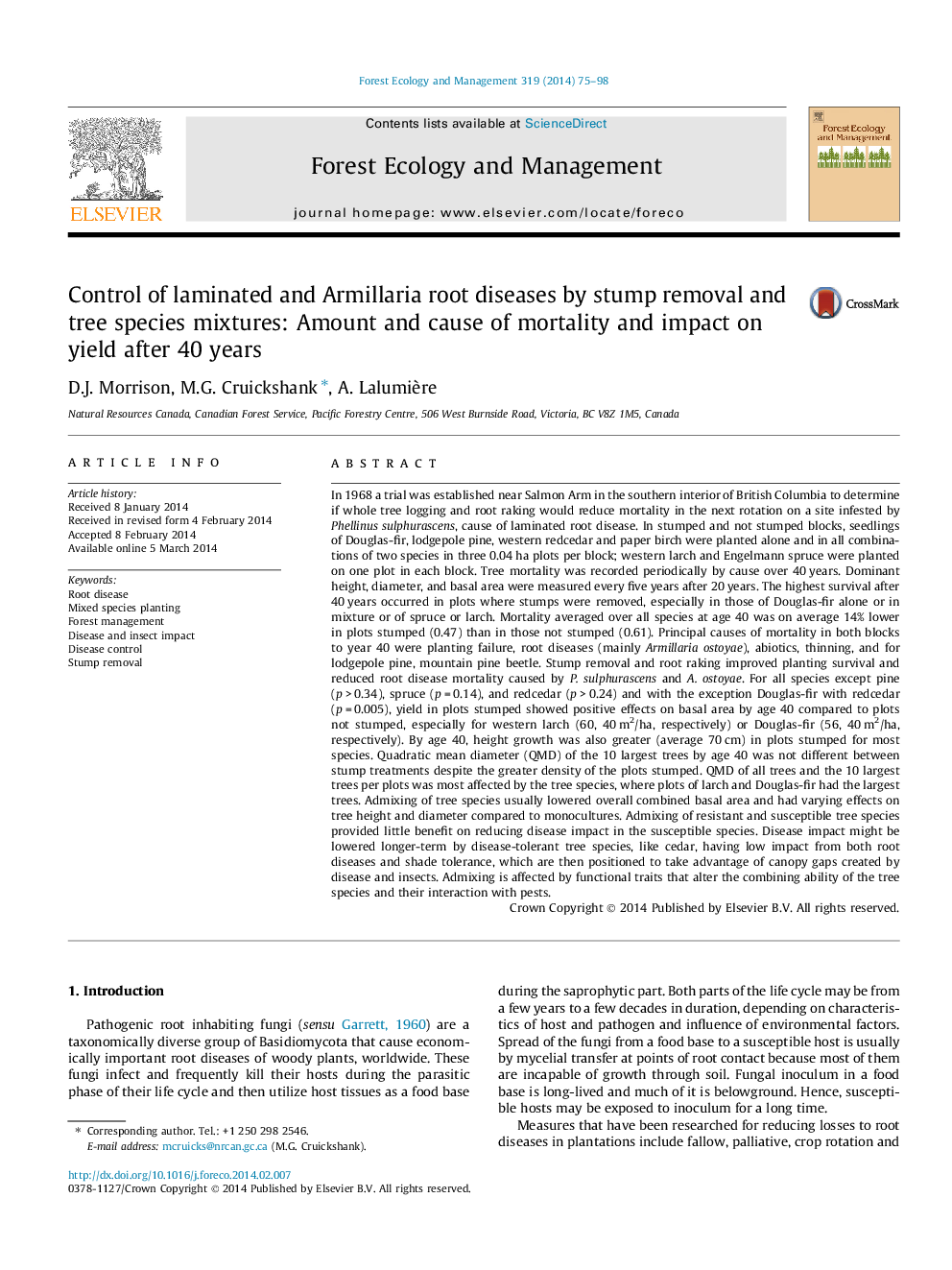| کد مقاله | کد نشریه | سال انتشار | مقاله انگلیسی | نسخه تمام متن |
|---|---|---|---|---|
| 86655 | 159202 | 2014 | 24 صفحه PDF | دانلود رایگان |
• Stump removal and root raking but not admixing reduced root disease mortality.
• Causes of mortality were planting failure, root disease, abiotics, and insects.
• Stump removal increased and admixture decreased plot basal area in most species.
• Stem diameter was unchanged by stump removal but varied by admixture.
• Dominant tree height was mainly increased by stump removal and varied by admixture.
In 1968 a trial was established near Salmon Arm in the southern interior of British Columbia to determine if whole tree logging and root raking would reduce mortality in the next rotation on a site infested by Phellinus sulphurascens, cause of laminated root disease. In stumped and not stumped blocks, seedlings of Douglas-fir, lodgepole pine, western redcedar and paper birch were planted alone and in all combinations of two species in three 0.04 ha plots per block; western larch and Engelmann spruce were planted on one plot in each block. Tree mortality was recorded periodically by cause over 40 years. Dominant height, diameter, and basal area were measured every five years after 20 years. The highest survival after 40 years occurred in plots where stumps were removed, especially in those of Douglas-fir alone or in mixture or of spruce or larch. Mortality averaged over all species at age 40 was on average 14% lower in plots stumped (0.47) than in those not stumped (0.61). Principal causes of mortality in both blocks to year 40 were planting failure, root diseases (mainly Armillaria ostoyae), abiotics, thinning, and for lodgepole pine, mountain pine beetle. Stump removal and root raking improved planting survival and reduced root disease mortality caused by P. sulphurascens and A. ostoyae. For all species except pine (p > 0.34), spruce (p = 0.14), and redcedar (p > 0.24) and with the exception Douglas-fir with redcedar (p = 0.005), yield in plots stumped showed positive effects on basal area by age 40 compared to plots not stumped, especially for western larch (60, 40 m2/ha, respectively) or Douglas-fir (56, 40 m2/ha, respectively). By age 40, height growth was also greater (average 70 cm) in plots stumped for most species. Quadratic mean diameter (QMD) of the 10 largest trees by age 40 was not different between stump treatments despite the greater density of the plots stumped. QMD of all trees and the 10 largest trees per plots was most affected by the tree species, where plots of larch and Douglas-fir had the largest trees. Admixing of tree species usually lowered overall combined basal area and had varying effects on tree height and diameter compared to monocultures. Admixing of resistant and susceptible tree species provided little benefit on reducing disease impact in the susceptible species. Disease impact might be lowered longer-term by disease-tolerant tree species, like cedar, having low impact from both root diseases and shade tolerance, which are then positioned to take advantage of canopy gaps created by disease and insects. Admixing is affected by functional traits that alter the combining ability of the tree species and their interaction with pests.
Journal: Forest Ecology and Management - Volume 319, 1 May 2014, Pages 75–98
